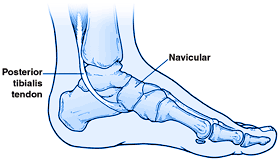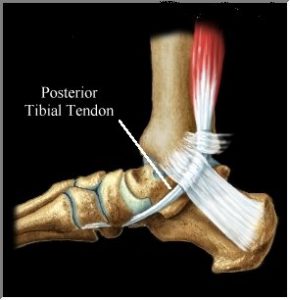Posterior Tibial Dysfunction / Tear
Conveniently located to serve Artesia, Rancho Cucamonga, and surrounding areas
 Description
Description
Tendons are fibrous tissue bands that connect muscles to bones. The Posterior Tibial Tendon is a strong band of fibrous tissue. It connects the Posterior Tibial Muscle to multiple locations on the inner and bottom sides of the arch. The function of this tendon is to help maintain the arch height (keep it from collapsing), and to help prevent pronation (a rolling out of the foot at the ankle, forcing one to put abnormal amounts of weight on the inner surface of the foot when walking). When this tendon becomes swollen, inflamed, and painful it is “sick,” and it cannot function properly. The terms for this condition are Tendonitis and Dysfunction.
Posterior tibial tendon dysfunction consists of a broad range of progressive disorders, including flatfoot deformity, tenosynovitis, and tendon rupture.
Anatomy
 The Posterior Tibial Muscle is situated on the back of the leg. Just above the prominent inner ankle bone, the medial malleolus, the muscle turns into a fibrous tissue band called the Posterior Tibial Tendon. This tendon runs behind the inner ankle bone, and enters the foot, traveling forward along the inner edge of the arch. Its main insertion is into the inner and bottom surfaces of the Navicular bone. The Navicular is a key structural component of our arch. The Posterior Tibial Tendon helps to maintain the height of the arch, and to prevent the foot from pronating, by pulling on the inner and bottom sides of the Navicular. This stabilizes and supports the foot in its normal or neutral position.
The Posterior Tibial Muscle is situated on the back of the leg. Just above the prominent inner ankle bone, the medial malleolus, the muscle turns into a fibrous tissue band called the Posterior Tibial Tendon. This tendon runs behind the inner ankle bone, and enters the foot, traveling forward along the inner edge of the arch. Its main insertion is into the inner and bottom surfaces of the Navicular bone. The Navicular is a key structural component of our arch. The Posterior Tibial Tendon helps to maintain the height of the arch, and to prevent the foot from pronating, by pulling on the inner and bottom sides of the Navicular. This stabilizes and supports the foot in its normal or neutral position.
Who Is Most Likely to Experience This Condition?
Posterior tibial dysfunction/tear is quite common in the elderly population and adults. Initially, it was mostly associated with people who had rheumatoid arthritis and progressive foot pain. However, in recent years, it has been observed in nonrheumatic populations as well.
Stages of Posterior Tibial Dysfunction/Tear
Stage I: The first stage of posterior tibial tendon dysfunction does not cause any deformity. The patient experiences pain along the posterior tibial tendon, but the foot appears to be otherwise normal.
Stage II: The second stage may be accompanied by the development of a deformity, which results in the collapse of the arch of the foot. While this deformity may not be visible, the patient experiences some weakness in the arch of the foot.
Stage III: In the third stage of posterior tibial tendon dysfunction, the deformity progresses to such an extent that the foot becomes fixed in a deformed position.
Stage IV: The fourth stage is the most severe and is characterized by a deformity in the ankle as well as the foot. This is caused when the deltoid ligament on the inside of the ankle fails. This can eventually also lead to arthritis of the ankle.
Causes of Posterior Tibial Dysfunction/Tear
The posterior tibial tendon dysfunction usually results from gradual degeneration of the soft tissue supporting the inner side of the foot. The problem is usually associated with a foot that starts out flat or pronated, since this type of foot places more stress on the medial soft-tissue structures.
There are cases where fully grown children also develop flat feet. If the deformity leads to functional limitations, it can eventually lead to soft-tissue failure and worsen the problem. There is a greater risk of developing posterior tibial tendon dysfunction in individuals who have the issue of recurring posterior tibial tendonitis.
Common causes of this dysfunction include:
- Age-related degeneration
- Overuse with attenuation
- Chronic recurrent tenosynovitis
- Inflammatory arthritides
- Acute traumatic rupture
Symptoms of Posterior Tibial Dysfunction/Tear
Symptoms of this condition include:
- Acute tendon pain in the inner part of the hindfoot and midfoot
- Difficulty in walking due to a deformity in the foot
- Swelling along the ankle, the foot, or both
- Flattening of the foot or inward rolling of the ankle
Treatment Options
There are several nonsurgical treatments available for posterior tibial tendon dysfunction. The medial longitudinal arch, which spans the underside of the foot, can be supported to relieve strain on the soft tissues of the medial portion of the foot.
The most effective types of support equipment to relieve the pain are leg braces and walking boots. Orthotic devices can also be used to slow the progression of deformity in mild cases.
In more severe cases, surgical treatments can be employed. These include:
- Flatfoot surgery
- Medial slide calcaneal osteotomy, which can correct the position of the heel
- Lateral column lengthening, which can correct the position of the midfoot
- Medial cuneiform osteotomy, also known as first metatarsal-tarsal fusion, which is performed to correct the elevation of the medial forefoot
- Posterior tibial tendon reconstruction, which involves grafting a healthy tendon or portion of the tendon from another part of the body to replace the dysfunctional tendon
Arrange Your Consultation
Contact My Foot Clinic and schedule a consultation to learn more about your treatment options for posterior tibial dysfunction/tear in Artesia. During your consultation, a skilled foot and ankle specialist will examine your affected foot and ankle. They will then determine the ideal solution for you.


